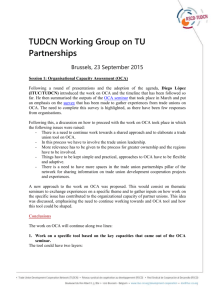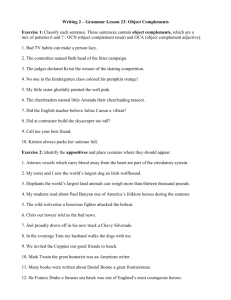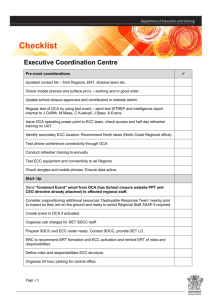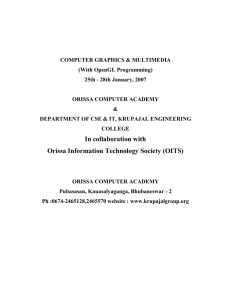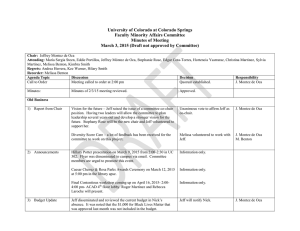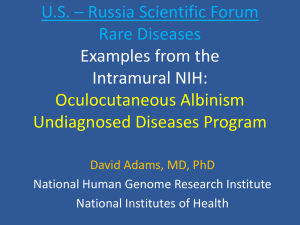Design and Use of an Ontology ...
advertisement
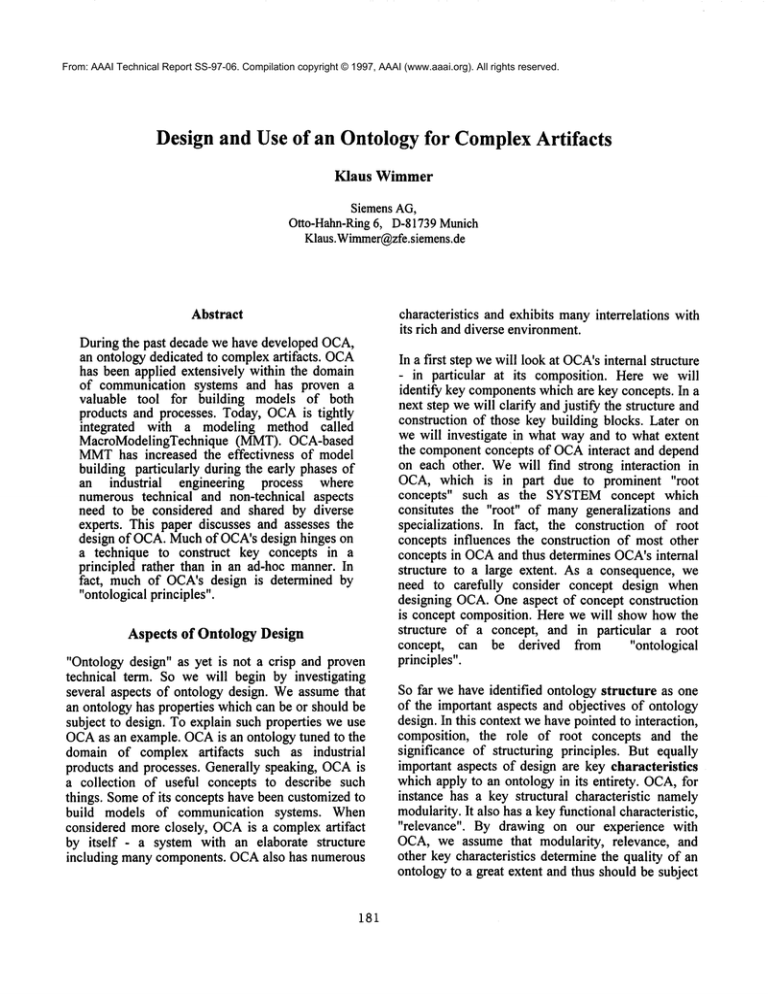
From: AAAI Technical Report SS-97-06. Compilation copyright © 1997, AAAI (www.aaai.org). All rights reserved. Design and Use of an Ontology for ComplexArtifacts Klaus Wimmer SiemensAG, Otto-Hahn-Ring6, D-81739Munich Klaus.Wimmer@zfe. siemens, de Abstract characteristics and exhibits manyinterrelations with its rich and diverse environment. During the past decade we have developed OCA, an ontology dedicated to complexartifacts. OCA has been applied extensively within the domain of communication systems and has proven a valuable tool for building models of both products and processes. Today, OCAis tightly integrated with a modeling method called MacroModelingTechnique (MMT). OCA-based MMThas increased the effectivness of model building particularly during the early phases of an industrial engineering process where numerous technical and non-technical aspects need to be considered and shared by diverse experts. This paper discusses and assesses the design of OCA.Muchof OCA’sdesign hinges on a technique to construct key concepts in a principled rather than in an ad-hoc manner. In fact, much of OCA’sdesign is determined by "ontological principles". Aspects of Ontology Design "Ontology design" as yet is not a crisp and proven technical term. So we will begin by investigating several aspects of ontology design. Weassume that an ontology has properties which can be or should be subject to design. To explain such properties we use OCAas an example. OCAis an ontology tuned to the domain of complex artifacts such as industrial products and processes. Generally speaking, OCAis a collection of useful concepts to describe such things. Someof its concepts have been customized to build models of communication systems. When considered more closely, OCAis a complexartifact by itself- a system with an elaborate structure including many components. OCAalso has numerous 181 In a first step wewill look at OCA’sinternal structure - in particular at its composition. Here we will identify key componentswhich are key concepts. In a next step we will clarify and justify the structure and construction of those key building blocks. Later on we will investigate in what way and to what extent the componentconcepts of OCAinteract and depend on each other. Wewill find strong interaction in OCA, which is in part due to prominent "root concepts" such as the SYSTEMconcept which consitutes the "root" of many generalizations and specializations. In fact, the construction of root concepts influences the construction of most other concepts in OCAand thus determines OCA’sinternal structure to a large extent. As a consequence, we need to carefully consider concept design when designing OCA.One aspect of concept construction is concept composition. Here we will show how the structure of a concept, and in particular a root concept, can be derived from "ontological principles". So far we have identified ontology structure as one of the important aspects and objectives of ontology design. In this context wehave pointed to interaction, composition, the role of root concepts and the significance of structuring principles. But equally important aspects of design are key characteristics which apply to an ontology in its entirety. OCA,for instance has a key structural characteristic namely modularity.It also has a key functional characteristic, "relevance". By drawing on our experience with OCA,we assume that modularity, relevance, and other key characteristics determine the quality of an ontology to a great extent and thus should be subject to design. In OCA,the design of root concepts is an example of a design for modularity. The design of "basic concepts", on the other hand, is an exampleof a design for relevance. In OCA,a concept qualifies as being basic if it meets certain criteria like level of abstraction, sophistication, and frequencyof use. The SYSTEM concept will serve as a good example of a basic concept. Concepts like SYSTEM gain both modularity and relevance from "ontological principles". As a consequence, such structuring principles play a prime role in the design of OCAand mayplay that role for other ontologies as well. Lastly, we will focus on the aspect that an ontology needs to be designed for and fit into an environment. OCAfor instance, does play the role of a tool which relates to particular tasks. Oneof those tasks is to describe a product in a comprehensive, simple, concise and canonical manner, and suitable for many kinds of users and uses of such descriptions. Design, thus, is only one phase in OCA’slife cycle whichalso includes phases of application and adaption based on practical experience. In this course, we have found it practical to regard OCAas a system where "system" may be defined in the way we have done in form of the SYSTEM concept which will be explained later on. OCAdecomposesinto three collections of concepts: ¯ the layer of generic concepts (GCL) ¯ the layer of basic concepts (BCL) ¯ ¯the layer of domainspecific concepts (DSCL) hundred domain specific concepts: SUBSCRIBER, NODE, SESSION, CONNECTION, PRODUCTXYZ. These are example concepts, of the communication systems domain. Notation. The notation employed here roughly follows conventions popularized by description logics; see, for instance, (Brachmanet. al. 1991) (Heinsohn et.. al. 1994). Version 1 of the concept SYSTEM below discriminates two points of view or roles named outside-view and inside-view. These roles relate SYSTEMto two of its component concepts named BOUNDARY and BODY. BODY,in turn, is related via two other roles to its component concepts CHARACTERISTC and STRUCTURE. Weuse capital letters for concept namesand we use indentation to indicate a concept’s composition. Note the differences between the notation for a concept and the notation for a taxonomy.Here, an indentation and an arrow indicate a subsumptionrelation between concepts given by their names. SYSTEM (version 1) BCL, GCLand DSPLare considered the top, core and bottom layers of OCArespectively. We are speaking of layers because of their interaction. Roughly speaking, the generic concepts are generalizations of basic concepts while the domain specific ones are specializations. Before we describe layer construction and layer interaction in more detail, here are some exampleconcepts of OCA. ¯ instance, is composed of several concepts, as sketched further below. generic concepts: GLASSBOX,BLACKBOX, COLLECTION,STUFF, FUNCTION,etc. basic concepts: SYSTEM, OBJECT, STATE, EVENT, INSTITUTION, DEVICE, MATERIAL, AUTHORITY, ACTION, CONCEPT, METHOD, COMPUTATION, PORT, FLOW, STRUCTURE, INTERACTION or TRANSITION. These basic concepts are themselves composed of concepts which also belong to BCL. The concept OBJECT, for outside-view BOUNDARY inside-view BODY seen-as-whole CHARACTERISTIC seen-as-pieces STRUCTURE Often we will be less explicit and take a notational shortcut by leaving out either concepts (version 2) roles (version 3), as indicated below. In the case version 3, we will even say that BOUNDARY and BODY are two views of a system. In cases when we makea particularly important discrimination we will call the resulting concepts "categories". BOUNDARY and BODYare categories. SYSTEM (version 2) outside-view inside-view 182 SYSTEM (version 3’) BOUNDARY BODY Key Components of OCA. Much of the design of OCA depends on two of its components the concepts SYSTEM and OBJECT. Both are considered basic concepts and root concepts where being "basic" is a functional characteristic and being "at the root" is a characteristic of structure. Belowwe will briefly explain SYSTEM (see the simplified version 4 of this concept). SYSTEM (version 4; simplified) NAME DESCRIPTION SELF BOUNDARY CHARACTERISTIC STRUCTURE BODY CHARACTERISTIC FUNCTIONAL-CH. STRUCTURAL-CH. STRUCTURE COMPOSITION INTERACTION ORDER RELATIONS-WITH-ENVIRONMENT For brevity, the definitions of the component concepts of SYSTEM are left undefined here but are, of course, defined in OCA. BOUNDARY,for instance, describes a system’s extention in space and time, the ports and the flows which enter and leave the system as well as several other thingsBODY describes e.g. the various structures a system may have. There maybe the structure of a system’s tasks, the structures of its hardware or software, the breakdown and an ordering of its assets or its organizational composition etc. COMPOSITION may represent a set of relations. Froman ontological point of view weare little interested in whether there are one or more relations, but rather whether there are different kinds of composition or how composition differs from interaction. To express such differences we employ views which are typical for relations. RELATION, thus, is another quite elaborate basic concept which must remain unexplained here. Note that SYSTEMguides the model builder who thinks about or describes, say, the structure of a 183 product. In this case, SYSTEMoffers several practical concepts or schemata or templates which guide the modelbuilder to distinguish several kinds of structure, i.e structures of a boundary and structures of a system’s body. In addition, SYSTEM offers a generic definition for each of these structures. OBJECT - as we shall see - provides even more conceptual guidance. Basic Concepts and Root Concepts Wewere inspired by Rosch (Rosch 1978) to use the term "basic concept". She maintains that there is a certain basic level of abstraction at which humans perceive more accurately than at other levels. In OCA,a concept qualifies as basic in terms of its usefulness, level of abstraction, sophistication and modularity. SYSTEM, as sketched above, counts as a basic and valuable concept. Bunge(Bunge 1979) has argued convincingly for the usefulness of the systemconcept in all domains, not only in the domain of complex artifacts as defined by Keil (Keil 1989). Note, however, that Bunge’s system-concept is not identical with OCA’sSYSTEM concept. In the past, we have used SYSTEMthousands of times as a tool and template to model hardware, software and organizations, products as well as processes. Based on our experience we consider the level of abstraction of SYSTEM to be practical. SYSTEMcompares favourably, for instance, to popular but more abstract concepts like "entity". As to its sophistication, SYSTEM is easy to grasp and much less complex than OBJECTand many of its domain specific specializations like SESSION.With respect to modularity, SYSTEM is flawless because it is entirely constructed from ontological principles as explained in the subsequent section on concept construction. In OCA,SYSTEM plays the role of a "root concept". SYSTEM plays this role because many concepts are derived from it or use it as a building block or component. The following taxonomy lists (incompletely of course) concepts whichinteract with SYSTEM. BLACKBOX --)SYSTEM --)EVENT --)COMPUTATION -)OBJECT -)PRODUCT-XYZ BLACKBOX, for example, is a generalization of SYSTEM which neglects all views in System except for the boundary view. In contrast, EVENTis a specialization of SYSTEM, i.e. a system seen under a dynamic aspect. COMPUTATION, in turn, is a special kind of EVENT,i.e. an event seen from a logical point of view only. OBJECT is an aggregation of many special kinds of SYSTEMas will be explained later. PRODUCT-XYZ finally, is a specialization of OBJECT and, thus, also interacts with SYSTEM. Obviously, if we choose to change the root concept SYSTEM, this would cause a kind of chain reaction throughout OCA. In that respect, OCAor any ontology with similar structural characteristics is a delicate instrument. This is whySYSTEM and in fact all basic concepts have been designedwith great care. But not only the basic concept layer (BCL)demands the attention of its designer. The layer of generic concepts (GCL)needs "usability design". Consider the many thousands of possible abstractions of OBJECT.Almost all of them are practically useless as modeling tools and must not populate GCLnor other layers of OCA.Thus, by limiting the scope of GCL,by creating and re-using root concepts, by careful concept construction and other design measures, OCAobtains its distinct functional and structural characteristics. Concept Construction The quality of OCAstrongly depends on properly built concepts.The concept SYSTEM is an obvious example. But, how to build a concept properly? Assumethat in many practical cases we may not be able to specify the extension of a concept. For instance, we hardly knowor want to enumerate all systems in a domain of industry. How then to construct the intension of a concept properly? Let’s start by looking at the intension of SYSTEM or rather at the discriminations it makes. E.g. we discern a system from its environment, a system’s boundary from its body, or take the system’s composition as being separate from its interaction. In this mannerwe 184 determine the concept’s intension by selecting discriminations. But it is very likely to makea bad selection, because of the huge number of possible discriminations. Imagine we would add to the intension of the generic concept SYSTEMsome highly specific discriminations e.g. whether a system is on-sale or not, deliverable before Christmas or after. Thus, proper concept construction leads us to the key question "which discriminations are the ones to make"?Canwe resort to "discrimination principles" which serve as guidelines during concept design? But even if we succeed and find proper discriminations, westill must aggregate those discriminations in order to arrive at an intension. In the case of SYSTEM, we must decide whether to make the boundary versus body distinction after having madethe distinction between the system itself and its environment. The question is, is it practical to discern boundaryand body of a system’s self as we have done in SYSTEM, or should we rather discern boundary and body of a system’s environment? Or, in more general terms, what is the proper context in which to discriminate boundary from body? While many authors (Sowa 1984) have pointed to the significance of such selectional constraints, few have dealt with discriminations and their aggregation. Ontological Principles In the following we will use the term "ontological principle" (OP) to refer to principles discrimination or of aggregation. Wewill furher explain what OPs are and where they comefrom. Examplesof discrimination principles (DP) used OCA are static versus dynamic,past vs. future, active vs. passive, internal vs. external, wholevs. part, and causevs. effect. A discrimination counts as a principle if it is used often and if it comesclose to the ideal of partitioning a given domain into two sets of things which are disjoint and equal in size. In other words, a DP combinestwo highly useful points of view. In practice wedeviate fromthis ideal in several ways. SomeDPs take more than two points of view, for instance, when we keep physical, logical and institutional things apart. SomeDPs apply only to a major part of a domain, other DPswill produce sets whichoverlap to someextent or are not equal in size. If we distinguish, for instance, processes from products in the domain of industry, we do not know and we do not care whether there are precisely as manyproducts as there are processes. It has proven to be a very useful distinction in spite of this deficiency. DPs are a small selection from a myriad of possible but less relevant discriminations, e.g. whether or not something is before-May, striped, on-sale or lessthan-23. DPs also preclude impractical discriminations like physical vs. colourful vs. legitimate. Nowwe can be more precise about OPs. An OP is called "principle" becauseit is used at the beginning of an order, i.e. an order of views. In the case of SYSTEM the distinction structure vs. characteristic is madebefore distinctions of lesser importance are being made. Of course we maylater distinguish many kinds of characteristics e.g. manykinds of form, colour, cost, performanceor dependability. An OPis called "ontological" because it constitutes a commitmentto the things existing in a domain. For example, we cultivate a dynamic view only if we expect dynamic things to "be" in a domain, things such as events, changes, transitions, processes or the passing of time. OPsare similar in nature to Aristotelian categories such as substance, quality, quantity, relation, time, position, state, activity and passivity. Ideally, these categories should meet two extremely tight constraints. The union of categories should cover the whole universe of human discourse and the intersection of categories should be empty, or in other words, all categories should be mutually exclusive. Since the times of Aristotle, however, practical problems have been encountered. It remained unclear, for instance, how to precisely separate quantity from time or space. Comparedwith Aristotelian categories, the OPs of OCAmust meet considerably lesser constraints. As has been indicated before, we restrict our domainto the domain of complex and primarily technical artifacts. Andmost importantly, we require that the intersection of merely pairs or triplets of categories should be (approximately) empty. Sources and examples of OPs. OPs are indeed omnipresent and used often and for a long time because they "reside" in grammars, taxonomies as well as in generic concepts.To build any kind of sentence, like "the bus stopped at Mainstreet" we are free to choose words like bus and stop. But grammar forces us to committo certain aspects, e.g. to time (has stopped or will stop), to activeness (stops or 185 stopped), to individualness (the bus or busses), and others. In everyday life we are unaware of these aspects even though they are used at all times and in all places. In analyzing commonspeech acts, Searle has distinguished a physical, logical and institutional points of view (Searle 1969), a very practical distinction employedby OCA. Suppose activeness has the following simple definition: a thing is viewedas active if it exchanges things with its environment or is able to exchange them; under the passive view, a thing doesn’t or is unable to do so. Distinguishing active from is a commonplaceand valuable practice, e.g. when we contrast printer and paper, program and data, tasks and resources, process and product, tools and material. In a similar manner we would consider those things as active which support or implement activeness, e.g. ports and flows, energy and force, intentions and obligations. The active vs. passive distinction - often madeimplicitly within taxonomies seems to be mastered intuitively without the discriminating views ever being named. Consider again a generic concept such as SYSTEM which has evolved over several centuries (Ricken 1984) and which is used today like a commodityand "naturally" associates with categories like compositionor interaction. At last we mayassume that if a discrimination has found its way into grammarsand generic concepts, and has thus been used often and for a long period of time, it should count as a valuable resource for the design of OCA.Of course, we may wonder why such resources have not already been exploited for concept construction. One reason may have been Kant’s verdict that ontologies in the scholastic sense are metaphysicalspeculation and thus unscientific. OCAemploys numerous OPs. A few of them have already been introduced informally by introducing SYSTEM.Some additional OPs will be introduced by OBJECT.Below is a simplified version of this rather elaborate concept. OBJECT static&active&physical-view static&passive&physical-view static&passive&logical-view static&passive&institut.-view DEVICE (1) MATERIAL(2) CONCEPT (3) AUTHORITY (4) dynamic&active&institutional-view... dynamic&passive&logical-view... (11)/ (12) Whenwe see some thing (T) as an object and use OBJECTto conceptualize T, OBJECTwill give us manypotentially relevant points of view; a fraction of which may be eventually used for describing T. OBJECTaggregates the discrimination principles static vs. dynamic,active vs. passive and physical vs. logical vs. institutional. Since these principles do not already appear in SYSTEM,they can be used to distinguish twelve kinds of systems, as indicated by the following taxonomy where SYSTEMsubsumes DEVICE,a component concept of OBJECT. SYSTEM "-)DEVICE "-)MATERIAL "-)CONCEPT --)AUTHORITY JOHN static-view physical-viewJOHN’S-SKIN-AND-BONES logical-view JOHN’S-KNOWLEDGE-OF-THE-LAW institut.-view JOHN’S-RIGHT-TO-DRIVE-A-CAR dynamic-view physical-view JOHN’S-BREATHING logical-view JOHN’S-THINKING institut.-view JOHN’S-PROMISING-TO-PAY-RENT The example also indicates that manythings may be classified as either static or dynamic.Static are, for instance, colour of skin, weight of bone, precision of knowledge, value of right, and so on. Dynamicare, for instance, the flows, throughputs,efforts, durations and changes which we associate with processes like breathing. Colour, of course, maychange with time. The way in which such change occurs, can be described under the dynamic view. But in spite of being subject to change, colour is amongthe static aspects of John becausecolour itself does not refer to changes, transitions, processes, events and other "dynamicthings". This little exampleshould indicate that we must develop points of view with great care. Particular care is required if we want to achieve modular descriptions, as explained in the next section. Design for Modularity A system which is considered physical, active, and static is called DEVICE,one which is considered to be logical, active, and static is called METHOD. A dynamic, active, and institutional system is called ACT.An object is thus conceived as several kinds of systems. Here is a more concrete example. We start by viewing John as being both static and dynamic. Next, werefine both views by adding physical, logical, and institutional views. After thus placing the physical vs. logical vs. institutional discrimination into the context of the dynamicview of John, we have created the proper contexts for adding further information about John’s breathing, thinking or makinga promise, respectively. Modularity is a highly valued design objective with respect to both an entire ontology, and its key components, like OBJECTand its specialization JOHN.Thus, if we add a dynamic view to a given static view of JOHNthis static view should not change. Likewise, if wemodifythe institutional view of John, the physical or logical views of JOHN should remain unaffected. Modularity, however, plays a prominent role not only when we modify a description or model but also for the "economyof concept construction", for instance, whenwe re-use SYSTEMrepeatedly to construct OBJECT, as explained above. In a similar vein, Mars (Mars 1995) has argued that ontologies be monotonically extendible and parsimonious. Ontological principles which can partition a domain are the basic "mechanism" to achieve OCA’s modularity. Ontological principles, however, serve merely as a proper starting point and much work 186 ensues from using them. In the practice of building OCA,principled concept construction has proven to be a tedious and challenging form of ontological engineering. Here are some examples. Suppose we start by discriminating a static system (STATE) from dynamic system (EVENT). This amounts scrutinizing all aspects which we have already associated with SYSTEM.E.g., we need to define what static or dynamiccharacteristics are and what static or dynamicboundaries are. So far wehave left BOUNDARY weakly defined. A system’s boundary has been loosely associated with a system’s extention in space and time, as well as its ports and flows. But principled concept construction demands a more complete and refined definition (here: the intension) of BOUNDARY because we must make sure that static boundaries and bodies be distinct from dynamic boundaries and that (the extensions of) boundaries and bodies do not overlap. Moreover, since OBJECT as defined above calls for 12 distinct kinds of system boundaries, we must eventually define what a physical, logical and institutional boundaryis, and so on. Simplyspeaking, a physical port is for physical things (e.g. paper, electric current), a logical port for logical things (e.g. data, methods), an institutional port for institutional things (e.g. rights, obligations, offers, funds and complaints). Underphysical aspects a system can be shaped or positioned in three dimensional space, and can extend in time. But how can a system extend or be shaped if seen from an institutional or logical point of view? Manysimilar questions came up during the design of OCA. Answeringquestions of this nature requires tedious work in most cases. Consider here that OBJECT comprises several hundred component concepts and each one of them needs to be carefully engineered in order to achieve modularity. Such issues are treated in more detail in (Wimmer& Wimmer1992) and (Wimmer1996). Roles OCACan Play OCAhas been used within industrial settings. In such a rich and diversified environment manymethodsand tools exist whichcompetewith or need to be adapted to OCA,and many kinds of tasks and actors may somehow benefit from OCA. Thus, OCAmay play numerousroles depending on its environment and, of course, on success factors like training courses for OCA’susers, tool support for OCA’suse, as well as OCA’sdomain-specific contents. 187 Below we will briefly sketch a few roles OCAdid play within a restricted environment where model building is a prominent task. Here, to build a model means to describe the technical and non-technical aspects of a complex product in a comprehensive, simple, and concise manner. In practice such descriptions tend to be bulky and have manyauthors and readers with diverse concerns, such as a product’s functionality or serviceability. To achieve an adequate quality of communication among all contributors to a product is indeed a problem whith many facets. One aspect is the complexity of the subject matter to be described another the resulting complexityand the "dynamics"of its descriptions. Thus, an important and promising role of an ontology would be to alleviate this problem of communication and of representation, in particular by reducing the complexity of domain models and by improving traditional modeling methods. It is our experience, that OCAserves this purpose. OCAcontributes primarily by guiding the model builder in conceiving and conceptually structuring complexsubject matter. According to traditional methods most model builders will conceive a domainas being populated by entities and relationships or by objects and attributes. In contrast, OCA’sbasic concepts such as OBJECTguide a model builder towards considering numerous relevant points of view and well-defined categories. Using OCA’sconcepts, model builders can proceed systematically - view by view and module by module. Building models in this guided manner contributes to clarifying commonterms and concepts and to define a canonical way of conceiving, expressing and sharing subject matter as well as augmenting OCA’sdomain specific parts. In contrast, imagine a model being constructed by many modelers who are free to define their own basic concepts in an ad-hoc manner. As a result, diverse and incompatible modeling styles would add to the complexity of a model and increase the efforts or risks of building, interpreting and maintaining a model. Because OCA can function as a "system of guidelines" for a modeler builder to produce canonical and many-faceted representations, OCA has become an integral part of a modeling method called MACROMODELINGTECHNIQUE(MMT). OCA-based MMThas been applied to diverse technical domains and during various phases of a product’s lifecycle. Last but not least, MMT has served to train novice modelbuilders. Besides this crucial role which OCAplays for model building, it can play other roles as well. In spite of its particular characteristics, OCAshares properties with other ontologies and can function accordingly. Such properties have been discussed, for instance in (Gruber 1992), (Neches et. al 1991), and (Lenat Guha 1990). Lenat D. B. GuhaR. V. 1990. Building large knowledge-based systems. Reading, MA:Addison Wesley MarsN. J. I. 1995. Whatis an ontology. In: The impact of ontologies on reuse, interoperability and distributed processing. Uxbridge, UK:Unicom Seminars Ltd. Acknowledgements NechesR., Fikes R., Finin T., GruberT., Patil R., I am greatful to Sabine Gandenberger, Angelika Heeht, Michael Kuchler and Bernhard Latocha, for sharing their thoughts with me. Senator T., Swartout W. R. 1991. Enabling technology for knowledgesharing. AI Magazine, 12, 26-56 Ricken F. ed. 1984. Lexikon der Erkenntnistheorie References und Metaphysik. Munich: .Verlag C.H.Beck. BrachmanR. J., McGuinessD. L., Patel-Schneider P. RoschE. 1978. Principles of categorization. In: F. and Resnick L. A. 1991. Living with CLASSIC.In: Cognition and categorization. Hillsdale N J: Lawrence Principles of semantic networks. San Mateo, CA: Morgan Kauffman Erlbaum Searle J. R. 1969. Speechacts - an essay in the BungeM. 1979. Ontology 11: a wormof systems. philosophy of language. Cambridge: Cambridge Dordrecht, NL: D. Reidel University Press SowaJ. F. 1984. Conceptualstructures - information Gruber T. 1992. Ontolingua: a mechanismto support portable ontologies. Technical report. Stanford CA: processing in mind and machine. Reading, MA: Addison Wesley KnowledgeSystems Laboratory, Stanford University WimmerK., WimmerN. 1992. Conceptual modelling HeinsohnJ., KudenkoD., Nebel B. and Profitlich H. 1994. An empirical analysis of terminological based on ontological principles. Knowledge Acquisition, 4, 387-406 representation systems. Artificial Intelligence 68, WimmerK. 1996. Exploiting the commonsense of 367-397 ontologicalprinciples. In: WorkingPapers of the Keil F. C. 1989. Concepts, lands and cognitive Third Symposiumon Logical Formalizations of development. Cambridge, MA:The MITPress Commonsense Reasoning, Stanford University 188


